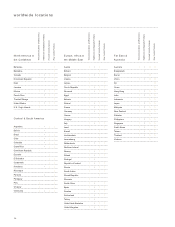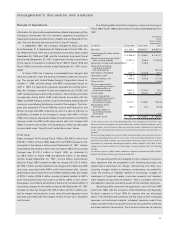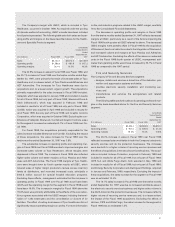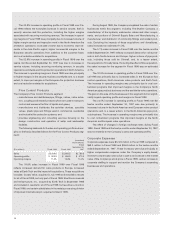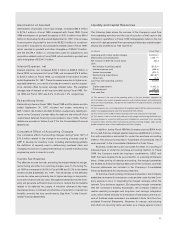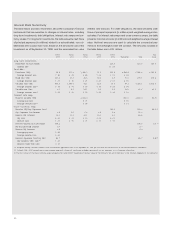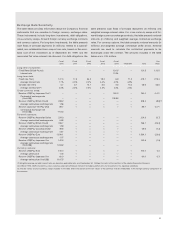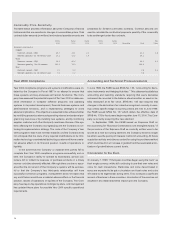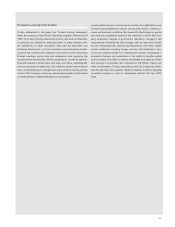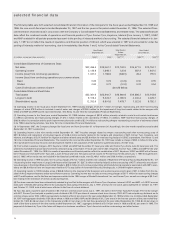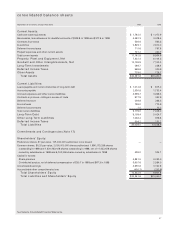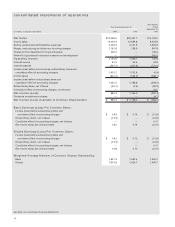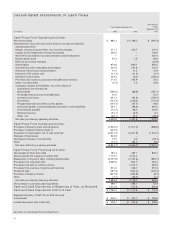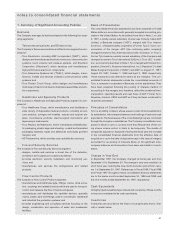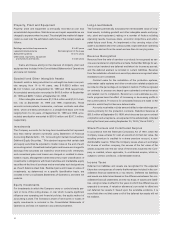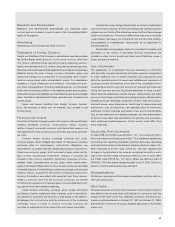ADT 1999 Annual Report Download - page 36
Download and view the complete annual report
Please find page 36 of the 1999 ADT annual report below. You can navigate through the pages in the report by either clicking on the pages listed below, or by using the keyword search tool below to find specific information within the annual report.
34
Commodity Price Sensitivity
The table below provides information about the Company’s financial
instruments that are sensitive to changes in commodities prices. Total
contract dollar amounts (in millions) and notional quantity amounts are
presented for forward commodity contracts. Contract amounts are
used to calculate the contractual payments quantity of the commodity
to be exchanged under the contracts.
Fiscal Fiscal Fiscal Fiscal Fiscal Fair
2000 2001 2002 2003 2004 Thereaf terTotal V alue
Forward contract s:
Copper
Contract amount (US$) 25.7 18.6 2.3 46.6 6.8
Contract quantity (in 000 metric tons) 16.1 11.6 1.4 29.1
Gold
Contract amount (US$) 33.0 20.6 53.6 5.6
Contract quantity (in 000 ounces) 120.0 75.0 195.0
Zinc
Contract amount (US$) 3.1 0.7 3.8 0.6
Contract quantity (in 000 metric tons) 3.1 0.7 3.8
Year 2000 Compliance
Year 2000 compliance programs and systems modifications were ini-
tiated by the Company in Fiscal 1997 in an attempt to ensure that
these systems and key processes will remain functional. The Com-
pany has assessed the potential impact of the Year 2000 on date-sen-
sitive information in computer software programs and operating
systems in its product development, financial business systems and
administrative functions, and is implementing strategies to avoid
adverse implications. This objective is expected to be achieved either
by modifying present systems using existing internal and external pro-
gramming resources or by installing new systems, and by monitoring
supplier, customer and other third-party readiness. Review of the sys-
tems affecting the Company is progressing and the Company is con-
tinuing its implementation strategy. The costs of the Company’s Year
2000 program to date have not been material, and the Company does
not anticipate that the costs of any required modifications to its infor-
mation technology or embedded technology systems will have a mate-
rial adverse effect on its financial position, results of operations or
liquidity.
In the event that the Company or material third parties fail to
complete their Year 2000 compliance programs successfully and on
time, the Company’s ability to operate its businesses, service cus-
tomers, bill or collect its revenues or purchase products in a timely
manner could be adversely affected. Although there can be no assur-
ance that the conversion of the Company’s systems will be success-
ful or that the Company’s key third-party relationships will have
successful conversion programs, management does not expect that
any such failure would have a material adverse effect on the financial
position, results of operations or liquidity of the Company. The Com-
pany has day-to-day operational contingency plans, and management
has updated these plans for possible Year 2000 specific operational
requirements.
Accounting and Technical Pronouncements
In June 1998, the FASB issued SFAS No. 133, “Accounting for Deriv-
ative Instruments and Hedging Activities.” This statement establishes
accounting and reporting standards requiring that every derivative
instrument be recorded in the balance sheet as either an asset or lia-
bility measured at its fair value. SFAS No. 133 also requires that
changes in the derivative’s fair value be recognized currently in earn-
ings unless specific hedge accounting criteria are met. In June 1999,
the FASB issued SFAS No. 137 which defers the effective date of
SFAS No. 133 to fiscal years beginning after June 15, 2000. The Com-
pany is currently analyzing this new standard.
In September 1999, the FASB issued an Exposure Draft on
the accounting for “Business Combinations and Intangible Assets.” If
the provisions of the Exposure Draft as currently written were to be
issued as a new accounting standard, the Company would no longer
be able to use the pooling of interests method of accounting. All future
acquisition activity would be accounted for using the purchase method
which could result in an increase in goodwill and the associated amor-
tization of goodwill above current levels.
Conversion to the Euro
On January 1, 1999, 11 European countries began using the “euro” as
their single currency, while still continuing to use their own notes and
coins for cash transactions. Banknotes and coins denominated in
euros are expected to be put in circulation and local notes and coins
will cease to be legal tender during 2002. Tyco conducts a significant
amount of business in these countries. Introduction of the euro has not
resulted in any material adverse impact upon the Company.


